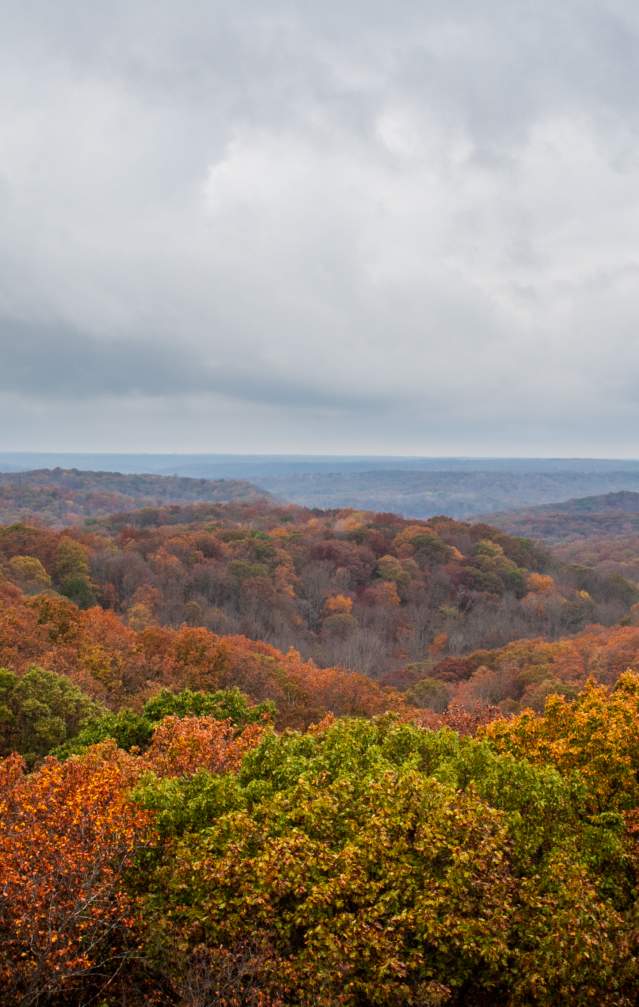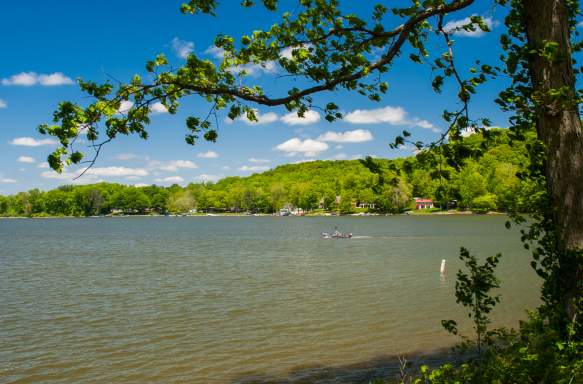Hiking, mountain biking, horseback riding, primitive camping — the Hoosier National Forest offers it all, and more.
Just 30 minutes from downtown Bloomington and the Indiana University campus resides Indiana's only national forest. Comprised of over 200,000 acres, tens-of-thousands of which are found in Monroe County, and Indiana’s only wilderness area, the Charles C. Deam Wilderness, the Hoosier National Forest offers a peaceful respite from the hustle and bustle of life, as well as a slew of nature activities to enjoy during any season.
Use this navigation list to easily jump from section-to-section:
Recreation Areas & Wildernesses
RECREATION AREAS

The Hoosier National Forest includes one recreation area and the state's sole wilderness area. The USDA Forest Service manages the Hardin Ridge Recreation Area, which is on Monroe Lake and offers a campground and two cabins, a boat launch ramp, a beach with a playground, an amphitheater, two picnic areas, three shelterhouses, the two-mile Hardin Ridge Trail, and the one-mile Ted T. Turtle Interpretive Trail.
CHARLES C. DEAM WILDERNESS

The Charles C. Deam Wilderness is a congressional-designated wilderness comprised of nearly 13,000 acres of the Hoosier National Forest. The wilderness is intended to be kept as just that: completely wild and primitive, offering visitors opportunities for solitude in a 100% natural forest-setting.
Features of the Deam Wilderness include:
- Eight different trails (Sycamore Trail, Hays Trail, Grubb Ridge Loop, Cope Hollow Trail, Martin Hollow Trail, Axom Branch Trail, Terril Ridge Trail, and Peninsula Trail) for a total of 36 miles of hiking, backpacking, and horseback riding.
- Twenty-five designated hike-in/boat-in primitive campsites, as well as dispersed camping following guidelines listed below.
- The historic Hickory Ridge Fire Tower that offers a view of Monroe County like no other.
- Fishing on Monroe Lake.
- Wildlife and plant viewing.
To protect the wilderness from damage:
- Group sizes are limited to a maximum of 10 people.
- All wheeled-vehicles (with the exception of ADA-compliant apparatuses) and mechanized equipment is prohibited.
- Never cut live trees for firewood.
- Carry out your trash rather than dumping or burning it — pack-out everything you pack-in.
- Only park in designated areas.
- Do not move or take artifacts from historical sites. The Deam Wilderness was once inhabited by Indigenous Peoples and early European Settlers — please leave remnants of that period as you find them so other visitors can enjoy and appreciate them as well.
- Camp only in designated areas.
- Only 25 designated campsites, all hike-in or boat-in, are offered in the Deam Wilderness — if all designated sites are occupied, you must set up your user-made campsite at least 100 feet from water & trails, and at least 300 feet from all trailheads. User-made sites located too close to the water cause erosion and degrade the wilderness environment & experience.
Please be respectful of this historic natural area by following the guidelines set in place by the Forest Service.
Camping & Cabin Rentals
DISPERSED CAMPING

Photo by Alyssa Hill
Dispersed camping is completely free and permitted throughout most of the Hoosier, so long as visitors follow the camping guidelines above in the Charles C. Deam Wilderness section. Although there is no charge for dispersed camping, please abide by the following restrictions:
- Stays are limited to a maximum of 14 days.
- Personal property must not be left unattended overnight.
- Group size is limited to 10 people in the Deam Wilderness and 75 people elsewhere in the forest. For camping groups larger than 75 individuals, a permit is required.
- Firewood must be in compliance with Indiana DNR standards.
For more information on dispersed camping restrictions, visit this page.
DEVELOPED CAMPGROUNDS

Photo by The Dyrt
There is one developed campground within the Monroe County section of the Hoosier National Forest at the Hardin Ridge Recreation Area. The camping season runs from mid-April to early-October each year. Like dispersed camping, there is a 14-day stay limit at the Hardin Ridge campground.
Hardin Ridge Campground
The campground at Hardin Ridge offers six camping loops and a total of 203 forested campsites for visitors. Sites are a mix of electric and non-electric. Some sites offer water hookups — several showerhouses with restrooms are scattered throughout the campground for those without water at their site.
Some sites are free and first-come, first-served, while others are reservable for a fee. For reservable sites, reservations must be made at least four days ahead of your trip, but can be made up to nine months in advance. Visit this website for availability and booking.
CABIN RENTALS

Hardin Ridge Recreation Area offers two rustic cabins available for rent near the shoreline of Monroe Lake. Amenities include electricity, centralized water, and a shared vault toilet. Cabins are available by reservation only.
Regardless of the camping experience you choose, be sure to practice Leave No Trace principles. Make sure to pack-out anything you pack-in, stay on trails as much as possible, and minimize your impact at campsites to ensure the area remains a beautiful place for future visitors.
Hiking, Backpacking & Trail Running
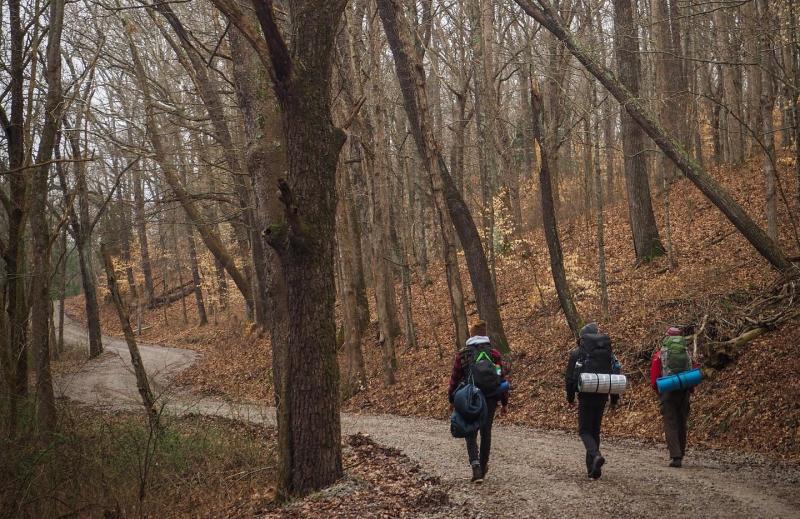
Photo by Zane Libke
The Hoosier National Forest offers hundreds of miles of trails, nearly 50 of which are in the Monroe County portion of the forest. Such an expanse of trails creates an abundance of combinations for day hikes and backpacking trips. Terrain spans from flat and dry to steep and muddy — trail trekkers will find closed-toe shoes and a walking stick helpful. Keep an eye out for horses, wildflowers, caves, waterfalls, historic sites, bald eagles, sweeping vistas, and other natural wonders as you venture through the Hoosier.
If you really want to get your blood pumping, give trail running a try. Trail running combines running with the challenge of navigating natural surroundings at a fast pace — the variety of trails available within the forest offers a range of intensity levels for your workout. The Pate Hollow trail system, near the Paynetown State Recreation Area, is limited to pedestrians only, so it's a great option for those seeking the ideal trail running location. Shoes specific to trail running are highly recommended for this activity.
The key to a great hike is preparation, so be sure to grab a trail map and pack plenty of water before you set off. Closed-toe shoes are necessary for navigating difficult terrain. Also know your limits — there's no shame in turning around on a trail if you feel too worn out to finish it! Remember that the distance you hike-in is the distance you have to hike back, so don't push yourself beyond what you're reasonably able to achieve. For curious pet owners: dogs are welcome in any area of the Hoosier National Forest as long as they're on a leash.
Hikers, backpackers, and trail runners have several trails to choose from in Monroe County's expanse of the Hoosier:
Easy Treks
- Hardin Ridge Trail at the Hardin Ridge Recreation Area
- 2 miles
- Used for hiking, trail running, and mountain biking
- Connects to the Ted T. Turtle Interpretive Trail
- Terril Ridge Trail in the Charles C. Deam Wilderness
- 1.9 miles
- Used for hiking, trail running, and backpacking
- Mountain bikers are not permitted to use this trail
- Connects to the Axsom Branch Trail
Intermediate Treks
- Axsom Branch Trail in the Charles C. Deam Wilderness
- 2.7 miles
- Used for hiking, trail running, and backpacking
- Mountain bikers are not permitted to use this trail
- Connects to the Terril Ridge Trail and the Grubb Ridge Loop
- Cope Hollow Trail in the Charles C. Deam Wilderness
- 5.9 miles
- Used for hiking, trail running, and backpacking
- Mountain bikers are not permitted to use this trail
- Connects to the Grubb Ridge Loop and Martin Hollow Trail
- Grubb Ridge Loop in the Charles C. Deam Wilderness
- 12.5 miles
- Used for hiking, trail running, horseback riding, and backpacking
- Mountain bikers are not permitted to use this trail
- Connects to the Hays, Peninsula, Axsom Branch, Martin Hollow, and Cope Hollow Trails
- Hays Trail in the Charles C. Deam Wilderness
- 2 miles
- Used for hiking, trail running, horseback riding, and backpacking
- Mountain bikers are not permitted to use this trail
- Connects to the Grubb Ridge Loop
- Hickory Ridge Trail 4 Loop in the Hoosier National Forest
- 4.2 miles
- Used for hiking, trail running, horseback riding, mountain biking, and backpacking
- Connects to the Hickory Ridge Trails 2, 10, and 18
- Martin Hollow in the Charles C. Deam Wilderness
- 3.5 miles
- Used for hiking, trail running, horseback riding, and backpacking
- Mountain bikers are not permitted to use this trail
- Connects to the Grubb Ridge Loop and Cope Hollow Trail
- Pate Hollow Trail System near the Paynetown State Recreation Area
- 6.7 miles
- Used for hiking and trail running
- Mountain bikers are not permitted to use this trail system
- Mountain bikers are not permitted to use this trail system
- Peninsula Trail in the Charles C. Deam Wilderness
- 2.6 miles
- Used for hiking, trail running, horseback riding, and backpacking
- Mountain bikers are not permitted to use this trail
- Connects to the Grubb Ridge Loop
- Ted T. Turtle Trail at the Hardin Ridge Recreation Area
- 1.2 miles
- Used for hiking and trail running
- Mountain bikers are not permitted to use this trail
- Connects with the Hardin Ridge Trail
Biking
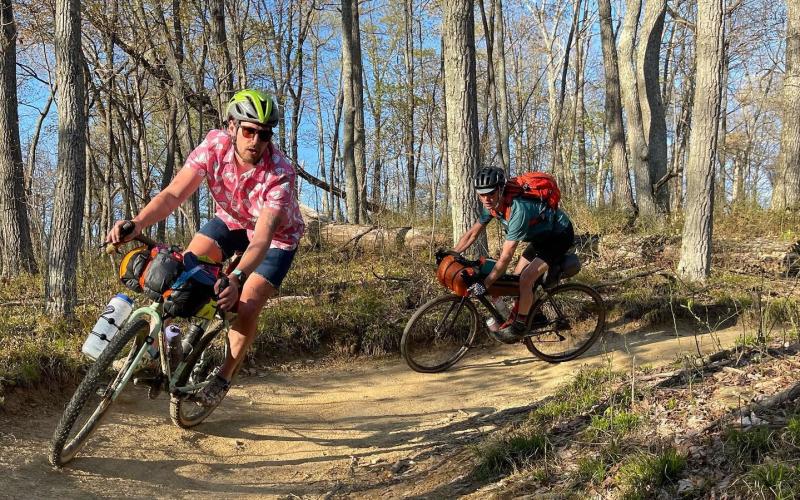
Photo by Tyler Tichenor
Road cycling and mountain biking are both popular at the Hoosier. The paved roads weaving through tracts of the forest are where iconic scenes of the Little 500-inspired movie, Breaking Away, were filmed. In Monroe County, street bicyclists can enjoy a challenging scenic ride on the hilly roads surrounding the Hoosier National Forest, as well as the roads that weave through the Hardin Ridge Recreation Area within the national forest.
The Hoosier also offers a few mountain biking trails in Monroe County with fun and challenging terrain for off-road cyclists, including the Hardin Ridge Trail at the recreation area and Trail 4 of the Hickory Ridge trail system south of the Deam Wilderness. Terrain features include rolling hills, level ridgetops, and steep slopes.
These are multi-use trails, so keep an eye out for horseback riders and hikers. Also be aware of hunters in the forest, especially during deer season. Always wear a helmet and be mindful of your surroundings to avoid injuries. Trail permits are required for riders ages 17+ on forest trails — the Hardin Ridge Trail is the only trail in the Hoosier National Forest that does not require a trail permit.
Climbing

Photo by @dontwannagive on Instagram
Rock climbing is permitted throughout the national forest, with the exception of a portion of Hemlock Cliffs. For those who are not experienced climbers, we recommend you attend classes at Hoosier Heights to obtain proper training before heading out to the national forest.
Please avoid disturbing plants on cliff faces while climbing and rappelling off rock walls. Plants in the Hoosier National Forest are fragile and include rare species — help us protect them and their environment by climbing with caution.
Fishing

Photo by @bloomingtonbasecamp on Instagram
Rivers, streams, ponds, and lakes are available for fishing throughout the Hoosier National Forest. In the Monroe County portion of the forest, there are an abundance of streams and ponds, as well as an expansive section of Monroe Lake. All water sources host a variety of stocked and naturally-occurring fish, including largemouth bass, bluegill, catfish, redear sunfish, and other species. Visit this page for more information on fishing on or around Monroe Lake.
Before you cast your line anywhere within the national forest, be sure to obtain an Indiana State Fishing License from the IDNR office for all anglers ages 18+.
Forest Bathing

Photo by Tyler Clowe
Forest bathing, or shinrin-yoku in Japanese, is the practice of connecting to nature by unplugging from the outside world and taking time to absorb the environment around you through all of your senses.
Power off your smartphone, amble through the trees at a leisurely pace, and let your body be your guide. Fully absorb the sounds, smells, and sights of the Hoosier National Forest — you can even hug a few trees if you want to feel all the more connected. Forest bathing isn't limited to strolling amongst the trees; you can also practice yoga, meditate, observe plant life, create natural art, and more. It's important to note the practice is not a physical exercise — forest bathing is simply connecting with nature through the five senses.
Proven health benefits of forest bathing include improved cardiovascular health, lower stress levels, decreased anxiety & depression, higher energy levels, and enhanced expression of anti-cancer proteins.
Horseback Riding

Photo by @dusty_flame_and_river on Instagram
While the Hoosier National Forest does not provide horses for riders, visitors are welcome to bring their own horses or use a guided-riding service from a private company. Every trail in the Deam Wilderness is open to horseback riders, and hundreds of miles of trails in the Hoosier outside of Monroe County are also available for equestrian use.
All horse riders are required to have a permit and stay on trails designated for equestrian use. Most trails are multi-use, so keep an eye out for hikers and mountain bikers. For those who wish to extend their day-trip into a longer excursion, there are five horse camps in the Hoosier that offer over-night stay experiences in the forest.
Horseback riders ages 17+ are required to have a trail permit.
Outdoor Education & Nature Viewing

Photo by @sunnhunt on Instagram
The Hoosier National Forest offers many programs and interpretive areas for visitors to observe and learn about the flora and fauna of the area in their natural habitat. Guide yourself on an interpretive trail with educational signs along the way, or check out a visitor program hosted at the Hardin Ridge Recreation Area.
Field guides are available at various visitors centers throughout the Hoosier for those seeking additional information about plant species in the area, and forest officials also recommend bringing binoculars to catch a closer glimpse of wandering wildlife. Please do not touch, remove, or harm any creatures — leave nothing but your footsteps, and take home only memories.
Sight-Seeing

Photo by @sunnhunt on Instagram
The Hoosier National Forest is a poignant reminder of just how beautiful and unique the rolling hills of Southern Indiana are. Hop in your car and go for a scenic drive around the forest grounds; climb the historic Hickory Ridge Fire Tower to watch the sun rise or set; admire sailboats as they glide by at the Moore's Creek State Recreation Area; bring binoculars to the Hardin Ridge Recreation Area for birding; trek the Peninsula Trail for a bit of forest bathing and an incredible view of Monroe Lake, or discover a breathtaking sight that isn't listed here. There's so much beauty within the Hoosier waiting to be explored.
For more unique sight-seeing opportunities, be sure to check out the national forest's Special Places Listings.
Water Activities
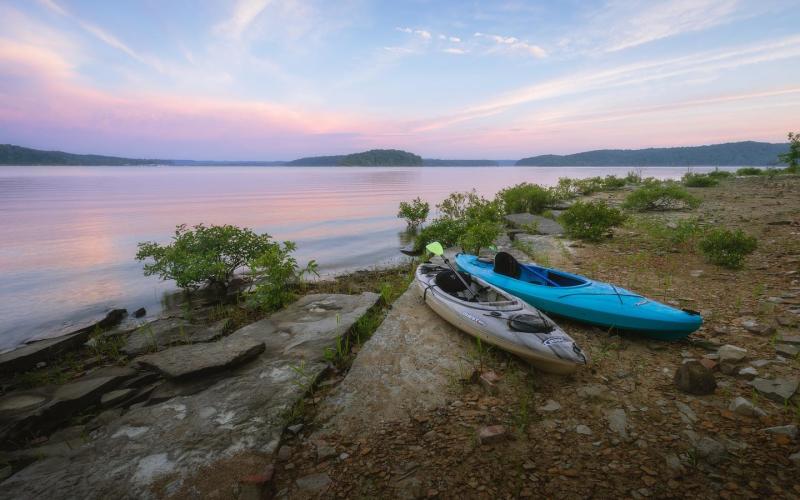
Photo by Logan Armbruster
As Monroe Lake is surrounded by the Hoosier, visitors can partake in many water activities. Bring your own paddleboard or kayak, or rent one from Lake Monroe Boat Rental or Two Herons Marina, and paddle around on the water. Boat into the Charles C. Deam Wilderness to hike for a few hours or to camp overnight. Swim on the beach at the Hardin Ridge Recreation Area, or just dip your toes in the water to practice forest bathing. You can even launch an electric-trolling fishing boat at a ramp within the forest to see what you can catch on the lake.
With any water activity you participate in, remember to Clean, Drain, and Dry your equipment to prevent the spread of invasive species.
Plan Ahead

Photo by @do_north on Instagram
The key to a successful and fun visit to the Hoosier National Forest is to plan ahead!
Determine which sights you'll see and which activities you'll partake in so you can pack the necessary equipment and outdoor apparel. Close-toed shoes and layers are highly recommended.
Plan to bring a lot of water — you don't want to get dehydrated while venturing through the forest.
Grab trail maps and/or a map of the entire Hoosier National Forest so you can avoid the possibility of getting lost. A compass may also prove useful. Trail maps are available at recreation areas, and the National Geographic Hoosier National Forest map is available for purchase in downtown Bloomington at J.L. Waters & Co.
Pack a first aid kit in case of minor injuries, and be sure to double check your list of essential medications, such as inhalers and Epi-pens, to ensure you've got them in your bag.
For those with dogs, bring plenty of dog food, a leash, and portable food & water bowls — a portable water bowl will come in handy on long hikes.
Create a checklist of things to do and pack before you venture out to the Hoosier to ensure you have the best experience possible!
Responsible Recreation & Land Stewardship

Photo by Patrick Milescu
The Forest Service's top priority is to maintain and improve the health, diversity, and productivity of the nation's forests and grasslands to meet the needs of current and future generations. The Hoosier National Forest, one of Indiana's and Monroe County's premier natural treasures, offers high-quality, resilient, and rare ecosystems that provide diverse outdoor recreational experiences to visitors.
Public lands belong to all of us, therefore it is every visitor's responsibility to help sustain them for present and future use. Land stewardship is key to keeping this beautiful natural wonder accessible for all to enjoy. Whether you're visiting for a day, weekend, or longer, please practice Leave No Trace principles and respect the land around you.
If you have any questions while visiting the Hoosier, feel free to stop by their Wilderness Welcome Center.

